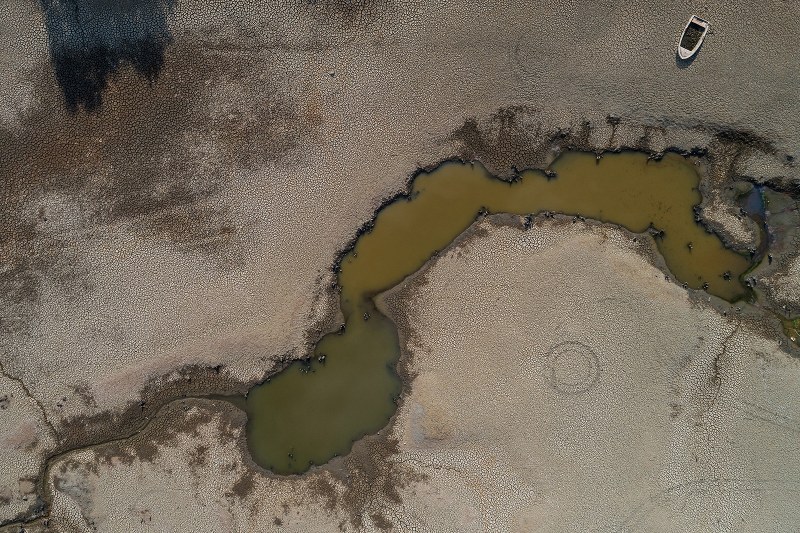Under our changing climate, the weather in Europe is getting more extreme. What could this summer bring in terms of heatwaves, droughts, floods, and forest fires? The overall outlook is pessimistic as we have already seen this past winter and spring. This makes adaptation to climate change and better preparedness crucial, according to a European Environment Agency extreme weather product published today, which explains the top weather-related climate challenges we face.
With the latest data available, the new EEA web product ‘‘Extreme summer weather in a changing climate: is Europe prepared?’ takes a deep dive into the main summer weather extremes that have increasingly impacted the European population, economy and nature. Users can explore interactive maps and charts information on heatwaves, floods, droughts and wildfires, and the rise of climate-sensitive diseases like dengue fever. The briefings on each of these extremes look back at past events, what we can expect in the future according to scientific projections, and how prepared we are to deal with them, including presenting examples and best practices across Europe.
The aim of the web product is to provide up-to-date information and data to raise awareness among decision makers and the public of the urgent need to address climate change and to support ongoing government efforts in putting in place climate mitigation measures and building societal preparedness.
Outlook: what could the summer bring?
More, stronger and longer heatwaves
Heatwaves that are dangerous to human health — like the heatwaves of the summer of 2022 — are getting more frequent, longer and more intense and will continue to do so under all climate scenarios. In southern Europe, especially, there may be more than 60 summer days during which conditions are dangerous to human health — meaning higher number of additional deaths and hospital admissions, especially among the elderly and the sick, unless adaptation measures are taken. Heatwaves are the deadliest extreme weather events in Europe and the increasing vulnerability of the European population due to ageing and urbanisation requires urgent implementation of measures to prevent loss of life.
More frequent, extreme flooding
Heavy precipitation events are projected to increase over most of Europe, leading to increased incidence of flooding, especially in north-western and central Europe. Adaptation measures are necessary to protect society from the worst impacts, such as those caused by flooding in July 2021 in Germany and Belgium.
The exposure of population and assets to the risk continues with the ongoing development of floodplains, often putting the more vulnerable populations and facilities such as schools and hospitals at risk. Between 1980 and 2021, damages due to flooding amounted to nearly EUR 258 billion and are on average rising every year by over 2%.
More frequent, severe droughts
Since 2018, more than half of Europe has been affected by extreme drought conditions in both winter and summer. The 2022 droughts substantially reduced yields of crops like maize, corn, soybeans or olive oil. Another dry winter does not bode well for this summer and the outlook is pessimistic. The exceptionally dry and warm winter meant low snow cover and resulted in little soil moisture, low river flows and reduced water storage in reservoirs in most of southern and western Europe.
Long-term climate projections indicate that southern and central Europe will become even drier and hotter throughout the 21st century with devastating consequences for the agriculture sector. Total economic losses across all economic sectors linked to droughts are expected to rise by the end of this century from the current EUR9 billion per year to EUR 25 billion per year at 1.5 degree Celcius (°C) of global warming, EUR 31 billion per year at 2°C of warming and EUR 45 billion a 3 °C warming based on scientific scenarios.
More widespread wildfires
Most wildfires in Europe are started by human activities but climatic conditions — dry and hot periods with strong winds – determine their intensity and impact. Forest fires largely affect southern Europe, but also increasingly central and even northern Europe. Since 1980, 712 people lost their lives across Europe as a direct impact of wildfires. The 2022 wildfire season was the second worst since 2000, with over 5,000 km2 (twice the area of Luxembourg) burnt during the summer months (June, July, August) and a record area of Natura2000 nature protection sites affected.
Under the high emissions climate change scenario, the south of Europe, in particular the Iberian Peninsula, will experience a marked increase in the number of days with high fire danger. The number of people living near wildland and exposed to high-to-extreme fire danger levels for at least 10 days per year would grow from now by 15 million (+24%) under the 3°C global warming scenario.
Rise in climate-sensitive diseases
Some disease-carrying species are widespread in Europe (such as ticks which can spread Lyme borreliosis or tick-borne encephalitis), while others are invasive (like Aedes albopictus also known as the tiger mosquito which can spread dengue fever). A warmer climate means both endemic and invasive species can spread further north or be present at higher altitudes than in the past. The climate suitability for the tiger mosquito is projected to increase in large parts of Europe, especially in western Europe which could become a hot spot for the mosquito by the end of the century.
Malaria could also re-emerge in Europe due to the widespread presence of the Anopheles mosquito species which can carry the disease. Increased rainfall and presence of stagnant water creates more habitat for mosquitoes, and warmer temperatures increase the mosquito bite rate and the development of the Plasmodium parasite that causes malaria.
What is being done to prepare and adapt?
Preparing our societies for climate change in Europe is driven by an EU policy framework (mainly EU strategy on adaptation to climate change and the EU Climate Law) and national policies. All EU Member States, plus Iceland, Liechtenstein, Norway, Switzerland and Türkiye (EEA member countries) have national adaptation policies already in place. The EEA monitors country adaptation planning and implementation by using reported information from Member States and other sources.
However, more could be done to link adaptation policies with sectoral policies, for example on health. Most national adaptation policies and health strategies recognise the impacts of heat on cardiovascular and respiratory systems. But less than half cover direct impacts of heat like dehydration or heat stroke.
There is an urgent need to upscale the implementation of adaptation measures such as heat-health action plans, boosting the number of green and blue spaces (trees and water) in cities which can lower temperatures and reduce the risk of flooding, or surveillance and early warnings for climate-sensitive infectious diseases.
Adaptation is urgently needed in agriculture. Farmers can limit adverse impacts of risking temperature and droughts by adapting crop varieties, changing sowing dates and with changed irrigation patterns. Without more adaptation, yields and farm incomes are projected to decline in the future.
The implementation of measures in practice often happens at the subnational level, therefore the commitment of local and regional authorities to adaptation is crucial. Over 4,500 cities, towns and municipalities are signatories to the Covenant of Mayors for Climate and Energy, committed to action on adaptation and more than 300 regions and local authorities have signed the Charter of the EU Mission for Adaptation to Climate Change. This latest EEA tool includes numerous examples of adaptation measures put in place across Europe, which are sourced from the EEA’s Climate-ADAPT portal.
Are you a journalist? And do you have questions about this product? Contact our press officers.













